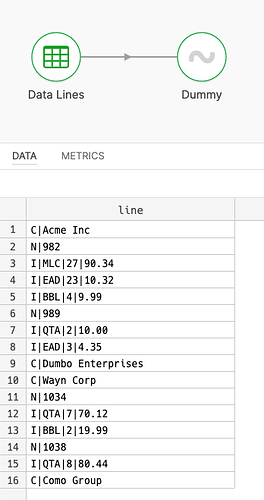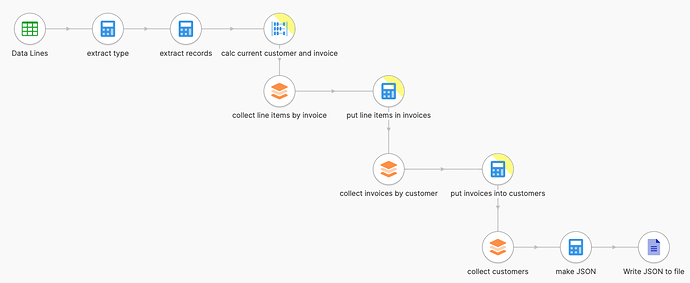For this challenge we have an input file that contains customer invoices including line items. The input file contains a variety of record types.
Input Data
C|Acme Inc
N|982
I|MLC|27|90.34
I|EAD|23|10.32
I|BBL|4|9.99
N|989
I|QTA|2|10.00
I|EAD|3|4.35
C|Dumbo Enterprises
C|Wayn Corp
N|1034
I|QTA|7|70.12
I|BBL|2|19.99
N|1038
I|QTA|8|80.44
C|Como Group
The following record types are given:
-
C- Represents a customer - customer name is delimited with| -
N- Represents an invoice - invoice number is delimited with| -
I- Represents an invoice line item - sku, quantity, and price are delimited with|
Each I record belongs to the first N record preceding it.
Each N record belongs to the first C record preceding it.
There are C records for which there are no invoices at present: see Dumbo Enterprises, and Como Group.
Requirements
We’re given the requirement to save the input information as a JSON structure. We need to save an array of customers, each with an array of invoices, which in turn each contains an array of line items.
If a customer does not have invoices, their invoices array should be empty.
Here’s the desired output format:
[
{
"type": "customer",
"name": "Acme Inc",
"invoices": [
{
"type": "invoice",
"nr": 982,
"line_items": [
{
"type": "invoice_item",
"sku": "MLC",
"count": 27,
"price": 90.34
},
// ... additional line items...
],
},
// ... additional invoices ...
],
},
{
"type": "customer",
"name": "Dumbo Enterprises",
"invoices": []
},
// ... additional customers ...
]
Starting Ooint
Use nested-flat-records-start.dfl (10.7 KB) to get started:



